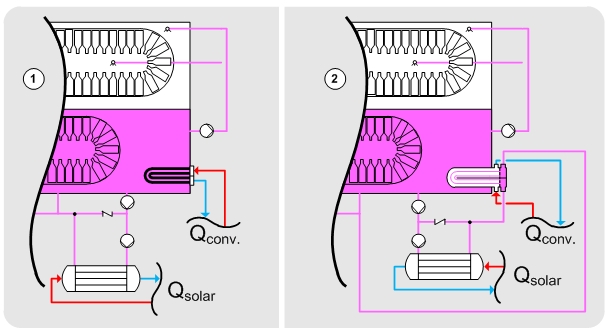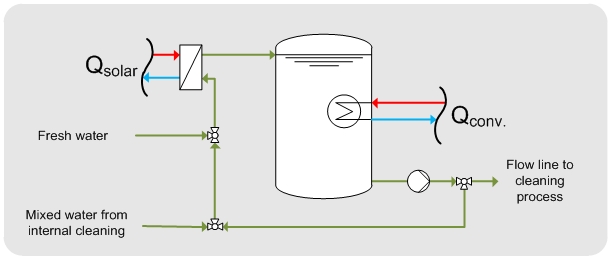Difference between revisions of "Solar integration guidelines in milk production"
From Efficiency Finder
(Created page with "Back to EFFICENCY FINDER OF FOOD INDUSTRY *Case studies **NEP Back to EFFICENCY FINDER OF FOOD INDUSTRY") |
|||
| Line 1: | Line 1: | ||
Back to [[Subsection DA food|EFFICENCY FINDER OF FOOD INDUSTRY]] | Back to [[Subsection DA food|EFFICENCY FINDER OF FOOD INDUSTRY]] | ||
| + | |||
| + | |||
| + | ===CLEANING=== | ||
| + | |||
| + | |||
| + | ====Cleaning of bottles and cases==== | ||
| + | |||
| + | |||
| + | {| class="wikitable" | ||
| + | |- | ||
| + | |[[File:Bottle_washing.jpg]] | ||
| + | |Example how to integrate solar heat for bottle washing machines in beverage companies. | ||
| + | The integration of solar heat for bottle washing depends very much on the type of the installed conventional heat exchanger and its integration into the machine. Bottle washing machines with an internal tube bundle provide the opportunity of overheating the caustic that is withdrawn from the region of the tube bundle, and pumped to the section where bottles enter the main caustic bath (scheme No. 1). At this point of the bottle washing machine, the highest temperature is required, so the caustic can be overheated by solar energy by 3..4 Kcompared to the temperature of the main caustic bath. | ||
| + | Using another tube bundle design, the caustic is removed from the bath and passes the tubes of the bundle. The steam entering the tube bundle heats the caustic within the tubes as well as the entire bath via its shell. A possible way of integrating solar heat in bottle washing machines using this type of heat exchanger is illustrated in scheme No. 2. The solar heat is used for preheating the caustic before entering the tube bundle. | ||
| + | |- | ||
| + | |[[File:Keg.jpg]] | ||
| + | |Example how to integrate solar heat for keg cleaning processes in beverage companies. | ||
| + | Kegs have to be cleaned from in- and outside. The interior cleaning is done with different spraystations (water, caustic, acid, hot water and steam).Keg cleaning lines have containers for the used media (water, acid, and caustic), which usually are kept at the required temperature by internal heating coils. | ||
| + | To utilize solar heat for keg cleaning, a heat exchanger has to be integrated in the flow line of the respective containers. The Figure illustrates this for a mixed water container. The return flow from internal cleaning is called mixed water and used to clean the exterior surface. Due to the illustrated way of integration, solar heat can be used to heat the mixed water directly while entering the container. The bypass is necessary to utilize solar energy also for heating the container between the cleaning batches. This can be neglected if a keg line is operated continuously.The illustrated integration scheme for heating the container of mixed water can also be applied to caustic and acid tanks. Usually, these media will have higher return temperatures and a cold water inlet is not given. | ||
| + | |- | ||
| + | !colspan="6"|Source: Schmitt, B., 2014. Integration of solar heating plants for supply of process heat in industrial companies (in German language), Dissertation University of Kassel, Shaker Verlag, Aachen, Germany. | ||
| + | |} | ||
| + | |||
| + | |||
| + | |||
| + | ====Cleaning of production halls and equipment==== | ||
| + | |||
| + | {| class="wikitable" | ||
| + | |[[File:CIP.jpg]] | ||
| + | |Example how to integrate solar heat for cleaning in place installations (CIP) in Food and beverage companies. | ||
| + | |||
| + | Cleaning-in-Place (CIP) is a method for cleaning process plants without removing single components. Therefore different cleaning cycles (daily to weekly) can be applied. Based on the respective production section, the cleaning is done with cold or hot water. A CIP system consists of multiple recovery tanks for acid, caustic, fresh and hot water, circulation and dosing pumps, one or more heat exchangers, and some other peripherals. CIP systems have often an external heat exchanger, which heats up the various media to the required temperature before they are pumped to the plant components that have to be cleaned. Through a circulation loop, the individual recovery tanks can be heated. | ||
| + | |||
| + | CIP systems with external heat exchangers are suitable for the integration of solar heat. If there are longer periods between the cleaning phases, the recovery tanks can be preheated with a smaller sized solar heat exchanger. If the set temperature is not reached through this measure, the conventional heat exchanger can supply the remaining thermal energy. | ||
| + | |- | ||
| + | !colspan="6"|Source: Schmitt, B., 2014. Integration of solar heating plants for supply of process heat in industrial companies (in German language), Dissertation University of Kassel, Shaker Verlag, Aachen, Germany. | ||
| + | |} | ||
| + | |||
| + | |||
| + | |||
| + | [[Solar application for cleaning]] | ||
| + | |||
| + | |||
*Case studies | *Case studies | ||
Revision as of 20:31, 10 February 2015
Back to EFFICENCY FINDER OF FOOD INDUSTRY
CLEANING
Cleaning of bottles and cases
Cleaning of production halls and equipment
Solar application for cleaning
- Case studies


